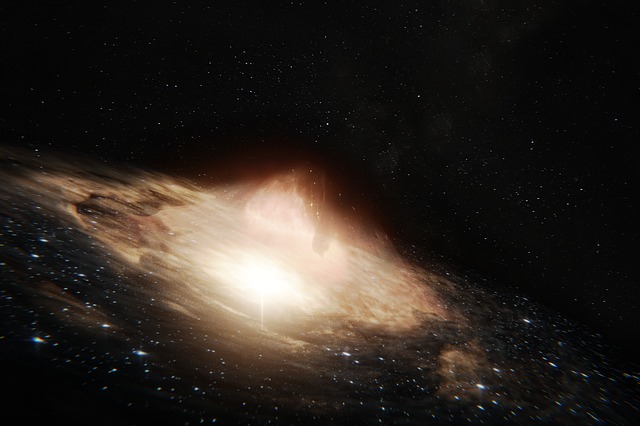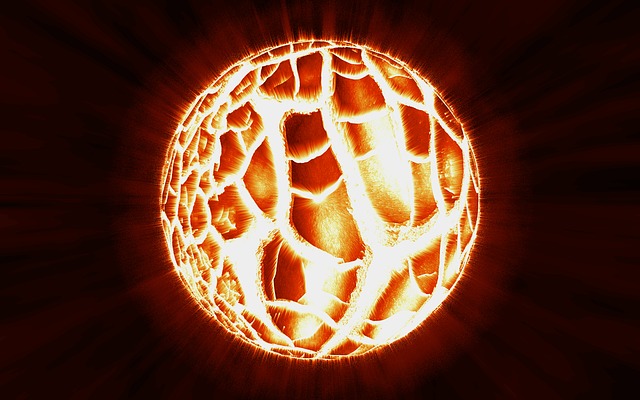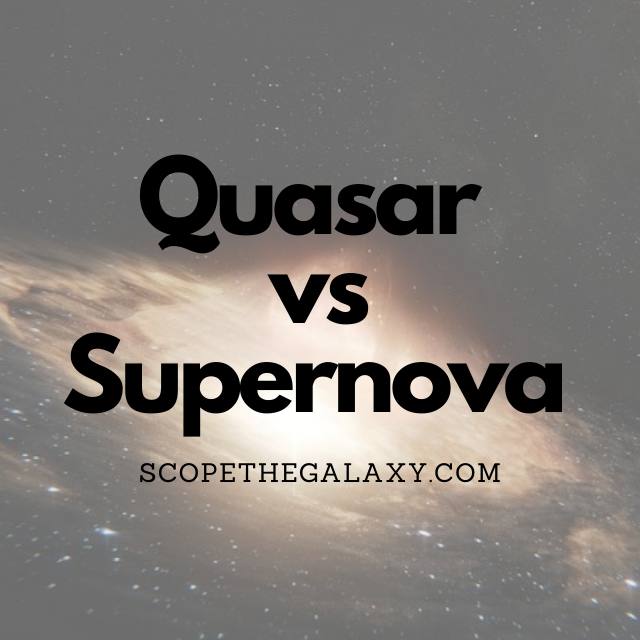*This post may contain affiliate links. This means we may make a commission if you purchase an item using one of our links*
The main difference between quasars and supernova explosions are that quasars are extremely bright light particles that surround supermassive black holes whilst supernovae occur when a large star collapses into itself and explodes in a short lived but grand explosion eclipsing even its entire galaxy in luminosity.
Both entities are similar in the sense they can be amongst the brightest objects around however, they are still very different in a variety of other ways. Continue reading if you want to find out more about these celestial objects.
What Is A Quasar?
Table of Contents

Quasars are the extremely bright celestial objects powered by supermassive black holes, that are found in the center of galaxies. They are also referred to as an active galactic nucleus.
Quasars were initially called quasi-stellar radio sources however, this name isn’t entirely consistent with the type of waves quasars generate as only around 10 percent of all quasars that have been discovered produce strong radio waves.
As for how bright they can be, quasars have been observed to exceed levels that are upwards of 100 times the brightness of the galaxies that hold them.
Although not an absolute, many scientists believe these bright objects are formed when light escapes at the edge of a supermassive black hole just before reaching its event horizon. Some light gets drawn in whilst other particles jet out at a tremendous pace, which is how the erratic and powerful light of Quasars form.
At this moment in time we have discovered roughly 750,000 unique quasars extending across various ages, with the farthest from us roughly 13 billion light years away.
Therefore, not only are these enigma’s extraordinarily powerful but they can even be used as time capsules to observe how our universe came to be, relatively close to when the theorised big bang occurred.
What Is A Supernova?

Supernovae are classified under 2 different types where a type 1 supernova is an explosion that leaves no hydrogen line emissions in the spectra and a type 2 supernova is distinguished where a star 15 times the mass of our sun explodes and does produce hydrogen line emissions.
There are two ways that a supernova explosion can form.
It can either be via a white dwarf in a binary star system that accumulates too much energy from its companion star causing it to explode or when a larger star runs out of nuclear fuel and collapses under its own gravity, leaving behind the bright and grandiose remnants of this explosion many times brighter than even its own galaxy.
As stated above supernovae are generally split into 2 types, a type 1 supernova or a type 2. Type 1’s are then further split into 1 of 3 subcategories, Ia, Ib or Ic.
A type 1a supernova is the most commonly observed in outer space and acts like a candle light to help us observe distance across the deep unknown.
These are theorised to form after a white dwarf, likely in a binary star system, exploding due to the over consumption of energy from its companion. Type Ia’s have a strong silicon absorption line near its maximum luminosity whilst producing no hydrogen at the same time.
Type Ib’s are formed after a large star collapses under its own core gravity where the outer region of the stars hydrogen is stripped away, leaving behind only the second layer of helium.
Type Ic’s lack both the hydrogen and helium layer when they explode, although the difference here has been debated as not being significant enough to differentiate a type Ib from a Ic.
Type 2 supernovae are formed when a star between 8 – 50 times the Sun’s mass collapses into itself and causes a huge explosion that produces either a neutron star or black hole. For black holes to form in this case, a star would require at least 3 solar masses worth of materials after the explosion.
In essence anything above 20 times the size of our Sun can potentially result in a black hole whilst a white dwarf star that is 1.44 solar masses or between 10 – 20 times the mass of our Sun would produce a neutron star instead.
Are Quasars More Powerful Than A Supernova?
Yes, quasars at the upper end of their brightness easily exceeds 100 times that of the average galaxy whilst supernovae also overpower the average galaxy but not to the same extent.
However, the difference between the 2 is that quasars can continue outshining galaxies for millions of years whilst a supernova explosion will only last for a few weeks at its peak therefore, this implies that quasars are the more powerful interstellar phenomena.
This is further expanded upon when you consider that the brightest object we’ve currently observed is a quasar.
Similarities Between A Quasar And A Supernova
Both are similar in the sense they can outshine entire galaxies and are linked to black holes because one creates black holes and the other surrounds it whilst jets of really bright light particles are projected in all directions.
Other than these similarities, both cosmic phenomena function in very different ways.
Differences Between A Quasar And A Supernova
As for the differences between the two, they are quite vast and include the following:
- Quasars can outshine thousands of galaxies for millions of years whilst supernovae only shine at a max brightness for a few weeks.
- Quasars are formed around and powered by supermassive black holes whereas supernova are explosion that create either neutron stars and smaller black holes.
- Quasars have a far longer lifespan than a supernova where supernovae live for a few months at most whilst quasars can exist for around 10 million years.
- Supernova explosions can produce temperatures around 1 billion degrees celsius whilst quasars are hotter still with a max theoretical temperature possibly eclipsing 100 billion degrees celsius.
- There are only around 2,000 quasars that we have currently discovered whilst supernova explosions will happen once every 50 years, in galaxies similar in size to the Milky Way alone making them far more abundant.
- Quasars are amongst the most distant objects in our universe as we’ve managed to spot one 13 billion years away from us.
Summary
Quasars and supernova explosions are very different from how they are formed, how long they stick around for, the differences in temperature and even in the energy produced.
The only real commonality between the two is that both are more luminous than entire galaxies when exerting their energy into the cosmos.

